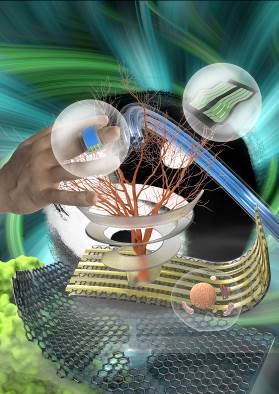[China Instrument Network Instrument Development] With the rapid development of nanotechnology, electronic devices have gradually developed toward miniaturization, multi-functionalization, and low energy consumption. The emergence of a large number of multifunctional flexible electronic devices such as communication, health monitoring, and environmental monitoring has greatly facilitated people's daily lives.

Image source Institute of Semiconductors, Chinese Academy of Sciences
However, the realization of continuous, long-term power supply for many flexible electronic devices, resulting in a flexible wearable self-driven sensing system is a great challenge to the existing power supply technology. Although the energy consumption of a single device unit is as low as microwatts to milliwatts, its large number and long-term working status, the total amount of power needed to maintain its normal operation is very large; at the same time, the traditional battery can not meet the needs of the system's full flexibility This greatly limits the application of flexible wearable systems. Flexible power supply is a key part of implementing a wearable self-driven sensing system. Energy collection and energy storage devices with bending, curling, and stretching functions are essential elements of a flexible power supply. In combination with nanomaterials and new nanotechnology, research on flexible power supply devices capable of matching with various functional wearable sensor devices has important research significance and application value for realizing permanent and stable operation of the self-driven sensor system.
Institute of Semiconductor Institute of Semiconductors, Chinese Academy of Sciences The State Key Laboratory of Superlattice Shen Guozhen has made a series of research progresses in the field of wearable self-driven sensing systems in recent years. Recently, the research group was invited to publish an overview article in the Wiley comprehensive journal Small, summarizing the major breakthroughs and advances made in the research field of flexible wearable sensing and self-driven sensing systems in recent years, and to the future of this field. The research hotspots were forecasted and analyzed. The article begins with the use of different functions, the wearable sensor is divided into wearable tactile sensors, including piezoresistive, capacitive and piezoelectric type; wearable image sensor, biosensor, gas sensor and multi-function sensing Integration, etc. In order to improve sensor performance and reduce device power consumption to better match self-driven systems, researchers have done a lot of groundbreaking research. The author then discusses the energy devices currently used in self-driven systems: 1) Energy harvesting devices, mainly based on piezoelectric and frictional power generation, thermoelectricity, and solar cells; 2) Energy storage devices, including lithium batteries and supercapacitors; It also presents its own opinion on the design and development of integrated wearable self-driven sensing systems that integrate energy harvesting, storage, and sensing applications.
This review can play a leading role for researchers interested in the field of wearable integrated systems. This work was supported by projects supported by the National Natural Science Foundation of China, the Beijing Municipal Natural Science Foundation, and the Frontier Science Key Research Project of the Chinese Academy of Sciences. The research results were recently published in the Small (DOI: 10.1002/smll.201701791) journal and were selected by the magazine as outer cover papers.
(Original Title: New Developments Made by Semiconductors for Flexible Self-Driven Wearable Sensor Systems)